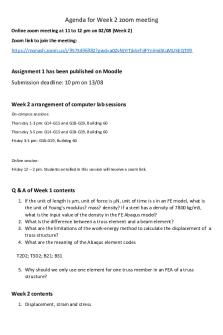DM Zoom 11:18:21 pdf PDF

| Title | DM Zoom 11:18:21 pdf |
|---|---|
| Course | Dental Materials |
| Institution | Valencia College |
| Pages | 3 |
| File Size | 38.5 KB |
| File Type | |
| Total Downloads | 49 |
| Total Views | 143 |
Summary
Download DM Zoom 11:18:21 pdf PDF
Description
Cutting: removal of material by a shearing off process Abrasion: wearing away of a surface Finishing: process of producing the final shape and contour of a rest Polishing: process of abraiding a surface to reduce the size of scratched until it is shiny Abrasive: the material doing the abrading Tribology: science of interacting surfaces in motion Types of abrasives: -chalk: calcite -pumice: volcanic ash -sand: quartz -cuttle: fine grand quartz -garnet: very hard/abrasive (silicates of manganese, magnesium, iron, cobalt, and aluminum) -emery: natural aluminum oxide -silex: silica-like material (similar to quartz) -tin oxide: final polishing agent for teeth and metallic restor. -aluminum oxide: replaced emery Bonded and Coated Abrasives: -diamond burs -stones -rubber wheels or points -rubber cups -disks or strips -polishing powders Factors Affecting the Rate of Abrasion: -hardness -size -shape -pressure -speed -lubrication
Why We Polish: -to reduce adhesion -to make the surface feel smooth -to increase esthetics -to reduce corrosion Preparation for Polishing: -review medical history -review charts for oral conditions/restorations -review radiographs Polishing is a series of steps where each step removes a layer of material by abrasion Polishing Technique: -slow speed -light, intermittent pressure -use the least abrasive agent possible Air Polishing Powders Sodium bicarbonate Aluminum trihydroxide Glycine powder Calcium carbonate Calcium sodium phosphosilicate (Novamin) Erythritol Contraindications for Air Powder Polishing -low sodium diet -respiratory disease -conditions that limit swallowing or breathing (COPD) -communicable infections -immunocompromised patients -patients taking potassium, antidiuretic, or undergoing steroid therapy
For dentures -inspect them in front of the patient -return them without deposits Dentifrices: -watch for abrasive content -ADA acceptance Abrasives used in Dentifrices: -phosphates -carbonates (sodium bicarbonate and calcium carbonate) -silica Factors Affecting Abrasion Rate by Dentifrices: -intraoral: xerostomia, saliva, exposed root surfaces, deposits, restorative materials -extraoral: type, size, and amount of abrasive in the dentifrice as well as the quantity of dentifrice used...
Similar Free PDFs

DM Zoom 11:18:21 pdf
- 3 Pages

Zoom-instructions - zoom
- 27 Pages

DM DM
- 39 Pages

DM-Revision - Sujet DM
- 1 Pages

Pasos examen TECS2GO Zoom
- 1 Pages

Wk2 zoom meeting agenda
- 2 Pages

1030bzoom - ZOOM ARRANGEMENT
- 2 Pages

SOP DM
- 2 Pages

DM traductologie
- 3 Pages

Zoom Recording Guide f2020
- 3 Pages

Antropometri DM
- 35 Pages

DM Photo
- 4 Pages

Leaflet DM
- 2 Pages

ASKEP DM
- 26 Pages

LEAFLET DM
- 2 Pages

MAKALAH DM
- 25 Pages
Popular Institutions
- Tinajero National High School - Annex
- Politeknik Caltex Riau
- Yokohama City University
- SGT University
- University of Al-Qadisiyah
- Divine Word College of Vigan
- Techniek College Rotterdam
- Universidade de Santiago
- Universiti Teknologi MARA Cawangan Johor Kampus Pasir Gudang
- Poltekkes Kemenkes Yogyakarta
- Baguio City National High School
- Colegio san marcos
- preparatoria uno
- Centro de Bachillerato Tecnológico Industrial y de Servicios No. 107
- Dalian Maritime University
- Quang Trung Secondary School
- Colegio Tecnológico en Informática
- Corporación Regional de Educación Superior
- Grupo CEDVA
- Dar Al Uloom University
- Centro de Estudios Preuniversitarios de la Universidad Nacional de Ingeniería
- 上智大学
- Aakash International School, Nuna Majara
- San Felipe Neri Catholic School
- Kang Chiao International School - New Taipei City
- Misamis Occidental National High School
- Institución Educativa Escuela Normal Juan Ladrilleros
- Kolehiyo ng Pantukan
- Batanes State College
- Instituto Continental
- Sekolah Menengah Kejuruan Kesehatan Kaltara (Tarakan)
- Colegio de La Inmaculada Concepcion - Cebu